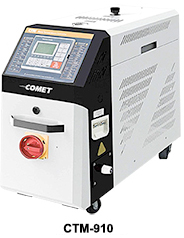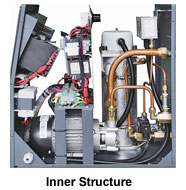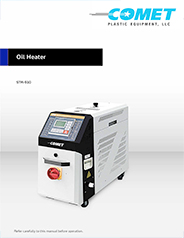CTM-O Oil Temperature Controller
Introduction
Comet’s CTM-O series oil temperature controllers are available in both standard and high temperature varieties. The Portable 350°F Hot Oil Units are on the lower end of our maximum heat range and are ideal for industries needing to control application temperatures. The Portable 375°F Hot Oil Units with Magnetic Drive Pump are mid-level and feature magnetic drive “seal-less” pumps differing from a traditional pumping system. The Portable 450°F Hot Oil Units with Magnetic Drive Pump are the highest level and also feature magnetic drive “seal-less” pumps.
350°F Features
- Heavy-duty powder sheet metal cabinet.
- Fill vent cap
- Three-phase electric immersion type
- Audible alarm and lockable cabinet
- Phase reverse protection
- Pressure relief valve
- Illuminated pump and heater on/off switches
375°F Features
- Ultra-low watt density design
- Y-strainer on pump suction
- Automatic air vent
- Three-phase motor overload protection
- Omrom 1/8 din non-proprietary PID controller
- Audible alarm and lockable cabinet
450°F Features
- Completely insulated machinery
- Ultra-low watt density design
- Pressure relief valve
- Casters
- Three-phase motor overload protection
- Audible alarm
When to Use an Oil Temperature Controller
- In areas where energy supplies are erratic, or the fuels themselves are of unreliable quality.
- In areas with intermittent electrical blackouts or brownouts, hot oil temperature control units will hold temperature better during electrical failure.
- When using polycarbonate and many ethylene-based resins, among others, because their melt points exceed the temperature control capabilities of liquid non-pressurized water.
- To quickly bring up the temperature in an extruder die or a mold before production begins.
- To increase efficiency by as much as 8% while eliminating flash and blow-down losses in systems operating at very low pressure.
- To prevent corrosion and reduce system maintenance.
- To maintain temperatures within ± 1°C which is difficult to control using electrical resistance for heating and forced air for cooling.
- To maintain liquid temperature control precision and uniformity while avoiding control and pressure issues of steam or high-pressure hot water.
Working Principle
Oil from the mold returns to the pump from the pipeline, where it is pressurized by the pump, conveyed to the heater, heated again, then returns to the mold in a repeating loop. During this process, if the oil temperature exceeds the set value, the system automatically activates the solenoid valve to enable cool water to lower the temperature indirectly until it reaches the system requirement. This is how a consistent temperature is maintained. If the temperature continues to increase and reaches the setpoint of EGO, or if the oil level falls below the setpoint, the system alarms and stops machine operation.





